Project 15: Thoroughbred Foal
This fine-looking Thoroughbred colt was born at Millford Farm near Midway, Kentucky. I visited the farm because his owner had commissioned me to paint a mare and foal. I had a good time observing and photographing a whole field full of mares and foals!
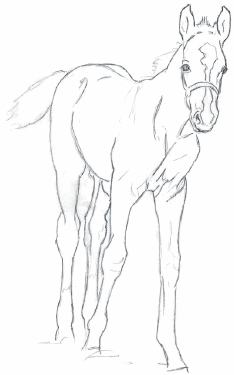

Reference Photo
Materials
Paints
Burnt Sienna
Burnt Umber
Cadmium Orange
Cadmium Yellow Light
Cerulean Blue
Naples Yellow
Permalba White
Raw Sienna
Ultramarine Blue Deep
Viridian
Yellow Ochre
Other Supplies
medium
turpentine
Brushes
no. 1, 4, 6 rounds
no. 4, 6, 10 filberts
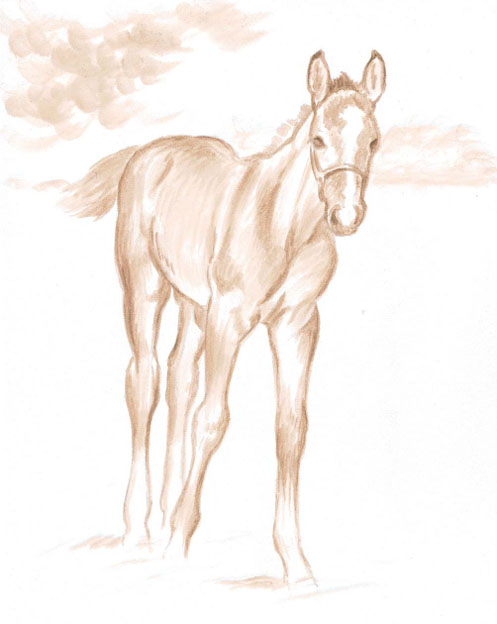
1 Establish the Form
Use Burnt Umber thinned with turpentine to indicate the main lines and shadowed areas of the foal. Use a no. 4 round for detail and a no. 6 round for the broader areas.
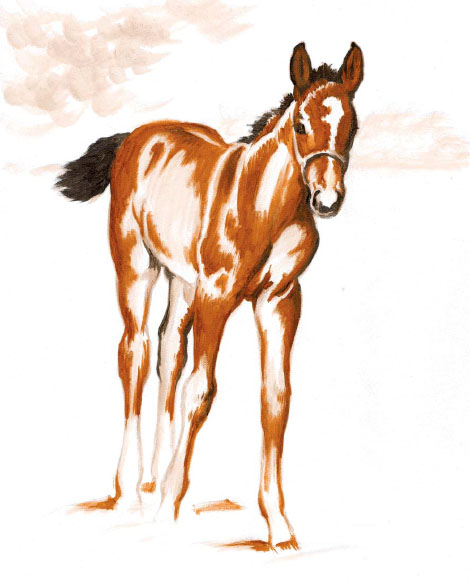
2 Paint the Darkest Values
Mix warm black with Burnt Umber and Ultramarine Blue Deep. Paint the darkest areas of the foal with a no. 4 round, using a no. 6 round for the tail. Mix dark red-brown with Burnt Sienna, Cadmium Orange and Ultramarine Blue Deep. Use smooth strokes, following the foal’s contours, using no. 4 and no. 6 rounds. Blend where the two colors meet with a separate brush. Use enough medium so the paint flows smoothly and is not too opaque. For broader areas, use a no. 6 filbert.

3 Paint Middle Values of Foal and Begin the Background
Mix the green tree color with Viridian, Burnt Umber, Cadmium Orange and Permalba White. Paint the closest tree with a no. 10 filbert, using dabbing, semicircular strokes. Mix the atmospheric blue for the distant tree line with Permalba White, Ultramarine Blue Deep, a little Burnt Umber and some of the green tree color. Paint with a no. 10 filbert with dabbing strokes.
Mix the sky blue color with Permalba White, Cerulean Blue and a little Naples Yellow. Paint with a no. 10 filbert with dabbing strokes, leaving a space above the tree line. Mix a light sky blue color with the sky blue plus Permalba White. Use a separate no. 10 filbert to paint just above the tree line, blending up into the sky blue. Paint around the foal’s ears with a no. 6 round.
Use no. 10 filberts to re-establish and lightly blend the near and far trees with the green tree color and atmospheric blue.
Mix the golden buff color for the lighter parts of the foal’s coat with Permalba White, Cadmium Orange and Yellow Ochre. Paint with a no. 10 filbert, using a separate no. 10 filbert to lightly blend with dark red-brown where the colors meet. Use no. 6 rounds for smaller areas. Paint with smooth strokes following the foal’s contours.
Mix blue-gray with Permalba White, Ultramarine Blue Deep and a small amount of Burnt Umber. Paint the bluish shadows on the foal’s hind legs and also around the nostrils with no. 4 rounds. Blend with the adjacent colors. Darken the mane and tail with another layer of warm black, using a no. 4 round.
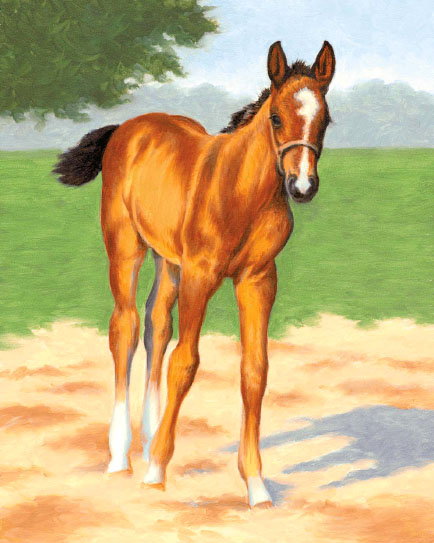
4 Paint the Straw and Field and Add Detail to the Foal
Paint the foal’s shadow with the blue-gray color and a no. 10 filbert.
Mix a straw shadow color with Permalba White, Raw Sienna and a little Burnt Umber and Ultramarine Blue Deep. Paint the shadows in the straw with a no. 10 filbert. Mix a straw color with Permalba White, Naples Yellow and a little Raw Sienna. Use a no. 4 filbert to paint the straw, lightly blending the straw shadows into the straw color with a no. 10 filbert. Use a no. 6 round to paint around the foal’s legs.
Mix the green field color with Viridian, Permalba White, Naples Yellow and Cadmium Orange. Paint smooth, horizontal strokes with a no. 10 filbert. Use a no. 6 round to paint around the foal’s contours.
Mix a bluish shadow color with Permalba White, Ultramarine Blue Deep, a little Burnt Umber and a touch of Burnt Sienna. Paint the shadows on the white parts of the legs with a no. 4 round. Blend with the adjacent color.
Use no. 4 rounds to paint the hooves with the dark red-brown for the shadowed parts, blending with the golden buff.
Mix warm white with Permalba White and a little Naples Yellow. Paint the blaze on the face with a no. 4 round, blending the edges with small strokes of the dark red-brown. Use no. 4 rounds to paint the lower part of the muzzle with the bluish shadow color, and add detail to the nostrils, blending with warm black.
Mix light brown for the halter with the straw shadow color and Permalba White. Paint with a no. 1 round. Reinforce the halter shadows with warm black and a no. 1 round.
Paint a thin glaze of dark red-brown over the dark red-brown and golden buff parts of the foal with a no. 10 filbert. Refine the shape of the foal’s right eye, then paint a highlight with a bit of the bluish shadow color and a no. 1 round. Let dry.
Tip
When mixing a color, check to see if the color is what you want by dabbing a small amount on your painting. Colors look different on a palette than on your painting. This way, you can make adjustments before committing to the color.
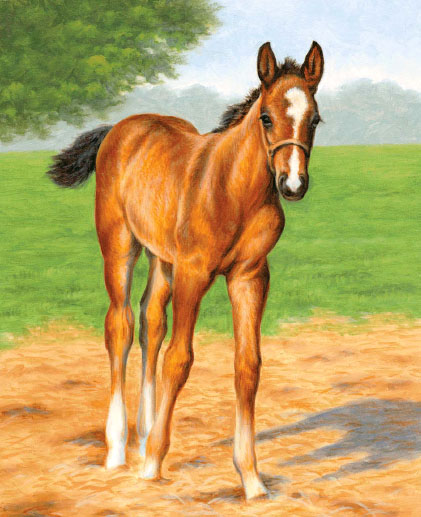
A FINE LOOKING COLT
Oil on Gessobord
8” × 10” (20cm × 25cm)
5 Finish the Drawing
Use a no. 4 round and dark red-brown to paint lightly over the golden buff areas of the coat. Darken the shadows on the hind legs with warm black, blending with blue-gray.
Paint a thin glaze of medium and Burnt Umber over the straw with a no. 4 filbert. Mix a tree highlight color with the green field color, Permalba White and Cadmium Yellow Light. Dab with a no. 6 filbert, blending lightly with the green tree color. Soften the edges of the tree with feathery strokes.
Paint shadows in the field with no. 6 filberts and the green tree color. Mix a grass highlight color with a portion of the green field color plus more Permalba White and Cadmium Yellow Light. With a no. 6 filbert, paint highlights. Use no. 6 filberts to paint vertical strokes of the green tree color and grass highlight color.
Paint detail in the straw with the straw shadow color and a no. 4 round. Use a separate no. 4 round with the dark red-brown to paint darker strokes in the shadowed areas. Use the straw shadow color and blue-gray to soften and blend.
Mix the coat highlight color with Permalba White, Cadmium Yellow Light and Yellow Ochre. Paint highlights on the coat with a no. 4 round, blending with the adjacent color and using separate no. 4 rounds. Add detail to the dark red-brown areas of the coat with the golden buff.
Paint highlights in the tail with blue-gray and a no. 4 round, blending with warm black. Define the left eye with blue-gray and a no. 1 round. Paint a highlight in the eye. Use warm black with a no. 4 round to darken shadows on the foal.
Paint a glaze of Ultramarine Blue Deep over the foal’s shadow with a no. 6 filbert, then darken the shadows in the straw. Blend the shadow edges with a bit of blue-gray.
With the coat highlight color and a no. 4 round, add a few strokes in the straw around the foal’s feet.
Tip
An oil painting will lose its sheen and the colors will become dull as they dry. Use a spray damar retouch varnish to lightly spray the painting before you begin to work on it again. It takes only a few minutes for the varnish to dry. This restores the colors so they look the same as when you applied them and will ensure that the colors you use in a new painting session will match the colors from the previous painting session.
